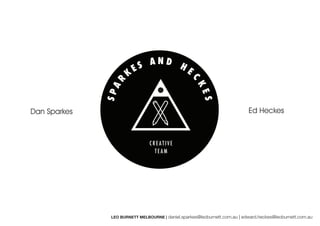Young Glory - Brief 2
- 1. AND H ES E K C R KE SPA S Dan Sparkes Ed Heckes CREATIVE TEAM LEO BURNETT MELBOURNE | daniel.sparkes@leoburnett.com.au | edward.heckes@leoburnett.com.au
- 2. Insight: When disasters hit, emergency vehicles are there for aid, but no one is there to help spread the word that individual people are ok, as communication/ power are often the first thing to be knocked out.
- 3. Idea: Only two types of vehicles head into affected areas: emergency response and news vans. Starting firstly with CNN, our idea is to use their news vans heading into disaster areas and refit them to be connection centres, helping spread the word people are ok.
- 4. As news vans already have satellite and connectivity capabilities, these would be increased, refitting the vans to make them news âconnectorâ vehicles (NCVs) - till reporting on the disaster, and also providing âconnectivity reliefâ s for those effected. CONNECTOR VEHICLES
- 5. CNN will also create a centralised aid page on their site, designed so people from the effected area can log in from the vans and say they are ok for friends/ family to check. LEO BURNETT MELBOURNE | daniel.sparkes@leoburnett.com.au | edward.heckes@leoburnett.com.au
- 6. Equipped with self-generating power (solar powered, huge battery stations), and upped connectivity capabilities, people use NCVs to: âĒ harge items (to repower spent phones/ laptops) C âĒ rovide free Wi-Fi, phone reception and P utilise the news satellite (to send word to others) âĒ se tablets mounted on the NCVs U (to connect to the site/ friends) âĒ emonstrates how people can D go on the connection website LEO BURNETT MELBOURNE | daniel.sparkes@leoburnett.com.au | edward.heckes@leoburnett.com.au
- 7. NCVs initially used by CNN, however eventually are adopted by other news stations globally as well. Awareness is raised through the news broadcast services themselves, with information on how to access the connectivity sites and more featured on the news website/ broadcast. LEO BURNETT MELBOURNE | daniel.sparkes@leoburnett.com.au | edward.heckes@leoburnett.com.au







